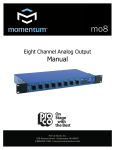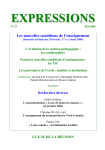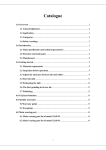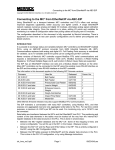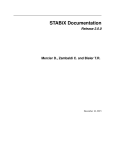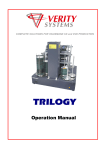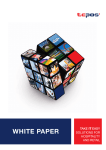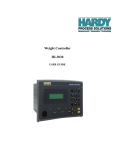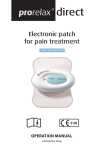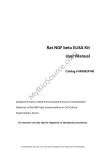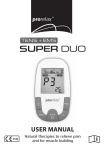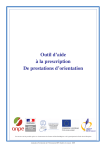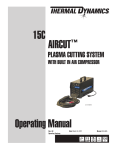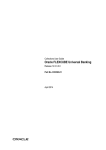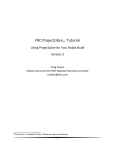Download Pharma Successful Tablet Compression
Transcript
Successful Tableting engineering for a better world 2/3 Why GEA? operational excellence For more than a hundred years, our innovation, driven by our passion for excellence, has pioneered tablet compression technology, allowing pharmaceutical and industrial companies to prosper, produce extraordinary products and change people’s lives. The innovations described in this brochure include a unique technology that independently and simultaneously measures and controls both tablet weight and hardness, and a weight control system that provides increased sensitivity at lower forces. Our presses offer an extended dwell time — up to 300% — resulting in higher outputs and enhanced productivity. And that’s just the tip of the iceberg. To meet your production challenges, we have developed a higher level of understanding of ingredient and manufacturing variables. And by implementing the philosophy of Six Sigma to reduce critical process variation and lean manufacturing to eliminate waste, our technologies and expertise can help you to produce a better quality tablet, reduce the risk of product failure, improve your cash flow and improve your bottom line profit. Our technology is world renowned for its reliability, flexibility and economy. We offer truly rapid changeover solutions, increased productivity, flexibility and safety. But it’s much more than that; it’s about how we work with you, the customer. We understand your needs; we use our expertise and know-how to develop solutions and optimise processes that bring your products to market quickly and provide the commercial advantage you need. Contents 1.0 Innovative Technology Our Beating Heart 2.0 3.0 4/5 5 Higher Weight Sensitivity, Extended Dwell Time 6–7 Independent Weight and Hardness Control 8–11 The PERFORMA™ Range of Tablet Presses 12–17 PERFORMA™ Lite 13–15 PERFORMA™ P 16–17 The MODUL™ Range of Tablet Presses 18–25 MODUL™ P 21 MODUL™ S 22–23 MODUL™ D 24–25 4.0 Bilayer Tableting: The GEA Way 26–27 5.0 Containment 28–29 6.0 Successful MUPS Production 30–31 7.0 Control Systems 32–33 8.0 Integrated Systems 34–35 9.0 Continuous Processing Technology 36–39 10.0 Data Sheets 40–44 11.0 Customer Care 46–49 12.0 Our History 50–51 13.0 Summary 52 1.0 Innovative Technology Our Beating Heart Innovation brings challenges, but it’s a challenge we welcome. We’re constantly looking to overcome hurdles with new technology and present new, unique solutions to the pharmaceutical industry. In fact, innovation is at the heart of all our products; it’s what makes them different. The quest for continuous innovation is the force that drives us every day, and flexibility, performance, accuracy and control are the criteria that focus our thinking. Everything we do is aimed at improving these key factors to help you to make better products and improve productivity. We’re leaders, not followers. We go our own way. We march to the beat of our own drum. We never try to copy or emulate, and that’s what gives us our edge, our advantage. That might mean that the road to success may be longer, but the end-product is better. The GEA experience is not just about buying a product, it’s about us working with you, getting to know you and understanding your requirements. It’s about customer care, know-how, service and communication, and benefiting from the dedicated group of people who make up the GEA family — a team of experts who listen to each other, respect each other and help each other to find the best solutions. We stand for what we believe in, which is why customers who buy from GEA stay with GEA. “ Working for a company that puts progress and innovation first makes leaving the house every day very appealing and stimulating. And, seeing the orders come in makes me feel positive about the future, my job security and my colleagues. Finally, working with customers all over the world is a great opportunity; I really feel like I’m making a difference. Isabelle, Dispatch ” 1.0 Innovative Technology Higher Weight Sensitivity, Extended Dwell Time Air Compensator the unique driving force behind GEA tablet presses The Air Compensator has a prosaic name; however, it's anything but ordinary. At the very core of GEA innovation, it’s what makes our tablet presses different, and better. It makes them special and it’s why pharmaceutical companies all over the world choose the GEA brand when performance, flexibility and process control really matter. Fitted to the pre-compression station of every GEA press, the Air Compensator is a unique device that comprises a piston-mounted roller that can move within an air cylinder. The air pressure inside the cylinder is monitored and controlled by the tablet press control system, which determines the pre-compression force applied to the tablets and ensures that it remains constant. The air pressure and distance between upper and lower rollers are set up to allow the roller to move a few tenths of a millimetre at each pre-compression. The variation in die filling will result in a change in tablet height at pre-compression, as the force applied always remains constant. This novel concept offers a number of unique advantages: Ultimate flexibility in tablet compression • as all the tablets are pre-compressed to the same density, any thickness variations are directly proportional to weight variations • extended dwell times at pre- and main compression by up to 300% • the strict linear relationship between tablet height and weight makes the setup much easier and faster, resulting in higher yields • constant dwell times regardless of machine speed • the sigma% of the height of the pre-compressed tablet is identical to that of the tablet weight, compared with the sigma% of a force signal, which does not relate to tablet weight at all • high-sensitivity weight control • every tablet compressed to the same hardness • automatic tablet rejection for incorrect weight and hardness. • higher sensitivity at low compression forces and when compressing small tablets compared with the more common force-controlled method • it is the fastest tooling protection system available; the Air Compensator pressure will always be less than the maximum force that can be applied on the tooling • the Air Compensator can be used in constant force mode at the main compression stage to ensure constant tablet hardness and porosity • the displacement of the compression roller results in longer dwell times (up to 300%), better de-aeration, less hardness and capping issues and much higher outputs; on some press models, the main compression dwell time can be set in the control system, meaning that it will remain constant regardless of the linear speed of the machine. 6/7 How it Works As the punch head touches the pre-compression roller, the Air Compensator allows the roller to lift until the required compression force is achieved. By measuring the displacement of the roller using a Linear Variable Displacement Transducer (LVDT), it is possible to measure the height of the tablet at pre-compression and, according to a strictly linear relationship, the weight. Similarly, by adjusting the pressure in the Air Compensator, it’s possible to adjust both the compression force and the dwell time without reducing the linear speed of the machine. The same principle can be applied at main compression to maintain a constant density/porosity on some of the press models. Every application is different and tablet presses need to be set according to the characteristics of the material feed and the specific production requirements. The Air Compensator enables fine adjustments to be made to all operational parameters; thus, users can achieve the desired security of outcome without compromising on machine speed and plant productivity. The main compression Air Compensator also acts as an effective tooling-protection device should compression forces rise above tolerances. No other presses in the world have this technology. The Air Compensator improves product output, overcomes compression issues and facilitates the pressing of small tablets. It makes the impossible possible. The superior process control improves tablet quality by continuously controlling both tablet weight and tablet hardness — optimising dissolution and bioavailability — as opposed to only weight in a conventional system. Offering weight control at pre-compression, extended dwell times for complex formulations, higher yields, cost savings and faster setup, the Air Compensator enables you to control two critical quality attributes instead of one. Operation is key, of course, and full training is offered to ensure optimal operation and productivity. “ The challenge of global travel suits me perfectly. Meeting customers all over the world and doing the very best I can for them gives me a great sense of satisfaction. Out there, I am representing the company and I feel it is my responsibility to leave people with the best possible impression of what we do and who we are. ” Niels, Customer Care 1.0 Innovative Technology Independent Weight and Hardness Control Enhanced dual process control, superior tablet quality When tablet weight is monitored at pre-compression, the main compression station is available for a second permanent control loop, which is totally independent from the weight control loop. This second loop eliminates tablet hardness fluctuations and automatically compensates for machine warm-up effects. Independent weight and hardness, or dual, control is a unique feature of all GEA MODUL™ and PERFORMA™ tablet presses and resolves a dilemma that has plagued the pharmaceutical compression industry since its infancy. Like all great solutions, the answer is simple: physically separate the two control loops to work on separate areas of the press. Weight is controlled at precompression and hardness is controlled at main compression. As a result, weight and hardness can be controlled simultaneously and continuously on a standard tablet press. The dual control system enables tablet rejection based on an out of tolerance displacement value at precompression or an out of tolerance compaction force value at final compression. Each individual tablet is checked twice before it is sent to the 'good-tablets' outlet chute. If one or both values exceed the pre-set tolerance limits, the tablet is rejected and sent to the ‘bad-tablets’ collection chute. This double check principle is unique to GEA's dual control system and offers increased tablet safety. 8/9 Existing Tablet Weight Control Loops Force controlled system: Unlike to the standard control systems on most tablet presses, the GEA one does not measure the compaction force during main compression for tablet weight control; the principle of “force measurement under fixed thickness” has some limitations regarding precision, validation and transfer to other machines. Indeed, the relationship between tablet weight and compaction force under fixed thickness is • non-linear and must be established empirically • dependent on machine rigidity • dependent on machine temperature. Moreover, the sensitivity of this relationship (the variation in force per unit variation of weight) decreases with reduced compaction force, which can lead to unacceptably high tablet weight variations with smaller tablets and during bilayer tableting when the compression force on the first layer must be very low to guarantee sufficient bonding between the two layers. This reduced lower compaction force sensitivity is also why compression force measurement for tablet weight control is always done during main compression — when the compaction force is highest. In addition, if the powder characteristics change during the compression of a batch, a control loop based on main compaction force measurement would have to be re-calibrated in either of the following ways: • by changing the main compression force input value, which might alter the hardness of the tablets • by changing the main compression height (the distance between punch tips in the main compression station), which will change the thickness of the tablets. It is not possible to re-calibrate the primary tablet weight control loop without affecting tablet thickness or hardness. Displacement controlled system: To address any issues regarding accuracy and repeatability, GEA adopted a different tablet weight control principle for rotary presses, based on • measurement of “thickness variations under fixed compression force” instead of “force variations under fixed thickness” • measurement during pre-compression instead of main compression. The most important characteristic of this principle is the linear relationship between what is measured (thickness variation) and what is to be controlled (tablet weight). As the height of the powder slug at pre-compression directly correlates to its weight when pre-compressed with exactly the same compaction force, thickness tolerance limits — as a function of weight tolerance — can be established in a straightforward manner. This results in • higher control loop precision as there are no rounding errors • easier parameter establishment and validation, as tolerance limits are calculated automatically by the control system. Furthermore, the relationship between tablet thickness at pre-compression and tablet weight is nearly independent of machine rigidity, making inter-machine transfers much easier. The influence of machine temperature is also negligible, which eliminates tablet weight variations owing to machine warm-up at the beginning of a production run. Moreover, a weight control principle based on “displacement measurement at pre-compression” has an increased sensitivity at lower compaction force, making the system particularly suitable for small tablets (where weight tolerance is tighter) and bilayer tableting. Another important advantage is that the primary control loop is re-calibrated by changing the pre-compression height (instead of main compression height in case of force control), leaving the thickness or hardness of the final tablet unaffected. 1.0 Innovative Technology Independent Weight and Hardness Control The GEA Additional Hardness Control Loop As the GEA weight control loop measures thickness variations (displacement) at the pre-compression station, the main compression station is left unused. As such, the main compression height is set to the correct tablet thickness at the beginning of the batch and can then be left unchanged for the duration of the batch. This operating mode is called “tableting under constant thickness,” whereby the main compression force — and tablet hardness — will vary with powder characteristics. Manual or automatic in-process sampling and analysis will detect out-of-tolerance tablet hardness values and will stop the press. Alternatively, the press can run in “tableting under constant hardness” mode by activating a second primary control loop: a force transducer on the final compression station measures the individual main compression forces and calculates a moving average, which is then used to adjust the main compression height and keep it between pre-set limits. This extra “hardness control loop” will correct any tablet thickness variations and keep the main compression force — as well as tablet hardness — constant. Tablet height variations are only allowed within pre-set tolerance limits. Otherwise, an alarm message is generated and the machine stops if tablet height limits need to be exceeded to maintain the appropriate compression force. Such a situation would mean that the powder characteristics have changed to such an extent that it is impossible to maintain all three relevant tablet parameters (weight, hardness and thickness) within their pre-set tolerance limits. The process would need to be stopped and powder characteristics and quality checked. The hardness control loop is re-calibrated after manual or automatic sampling and analysis, by changing the set point of the main compaction force. The change in force set point is calculated on the basis of the difference between the real average hardness and its target — nominal — value. Re-calibrating the hardness control loop is done in parallel with re-calibrating the weight control loop. When the hardness control loop is switched off (in constant height mode), the individual compression forces and their average values can still be displayed graphically on the HMI. A stop function is then available if the average compression force goes beyond pre-set stop limits. 10/11 Advanced Dual Control Advanced dual control is fitted to all PERFORMA™ P and MODUL™ P tablet presses and may be selected, or not, as required. At pre-compression, the tablet weight is measured in the same way. In addition, the active main compression Air Compressor allows dwell time to be controlled and the applied force to be regulated for each compression — ensuring that every tablet has the same hardness (porosity). This system is used for medium-volume production and R&D operations when absolute control of all operational parameters is essential, especially when dwell times need to be extended without any loss of linear speed. Dual Rejects Dual control also allows individual tablets to be rejected if they are out-of-tolerance on either weight or hardness. This feature helps to ensure the consistency of batches and significantly reduces wastage. As such, it is of particular importance when working with highvalue APIs and for R&D operations. Benefits of Dual Control • Individual control of tablet weight and hardness • High sensitivity weight control even for small tablets and those requiring low compression forces • Maintain the same dwell time regardless of the linear speed of the machine • Improved tablet quality • Improved productivity • Better tablet consistency • Reduced capping and sticking • High-speed operation • Dual reject feature. “ Applying the latest technologies and getting the most out of them to make our machines even better gives me a great sense of achievement. It makes me proud to be able to deliver top quality equipment, within the agreed timeframe, with the project team and with the customer. ” Dirk, Assistant Operations Manager 12/13 2.0 The PERFORMA™ Range of Tablet Presses Original, Effective and Economical – PERFORMA™ LITE PERFORMA™ LITE the essence of robust and reliable performance The GEA PERFORMA™ LITE is a robust, high performance, fully automatic tablet press that is ideally suited to heavy duty, high-yield applications. The PERFORMA™ LITE is the original GEA press, the technology behind the entire pharmaceutical range. It is flexible, reliable, fully accessible and offers outstanding, cost-effective productivity. The PERFORMA™ LITE includes many standard features and, as with all GEA tablet presses, it also benefits from the unique precompression Air Compensator, providing highly sensitive weight control and the option to extend dwell times by up to 300% without reducing linear speed. The main compression Air Compressor remains fixed to provide tool protection. Large, spring-loaded doors and the absence of corner pillars or columns allow easy access for cleaning and routine maintenance. The PERFORMA™ LITE is compact, simple to operate, produces high quality tablets and has gained a reputation for both economy and a rapid return on investment throughout the global pharmaceutical industry. Not a copy, not a reproduction, the first-in-class PERFORMA™ LITE may well be just the solution you need! 2.0 The PERFORMA™ Range of Tablet Presses Original, Effective and Economical – PERFORMA™ LITE Exchangeable Turret A key feature is the exchangeable turret, which allows maximum flexibility and enables product changeover in just 30 minutes using a semi-automatic exchange sequence. This minimises downtime, maximises productivity and allows easy access to the compression area for cleaning and maintenance. Data Collection The MULTI-CONTROL 5 is the latest GEA control system for rotary presses. The system’s hardware and software are designed to allow for full compliancy with the 21 CFR PART 11 guideline. It is a fully automated monitoring, control and reporting system based on a PLC/PC hardware configuration. MC5 features • Standalone PC application (all-in-one), independent from Windows operating system • Microsoft Windows 7 operating system (optional Windows 8) • 21.5” HD multi-touch widescreen • Desktop PC or industrial IPC • Siemens PLC (S7-300) for machine control • Software design and lifecycle management according to GAMP and internal ISO procedures (QMS) • Integrated help system, with user manual, machine operation manual, mechanical and electrical drawings. Benefits • Fast product changeover • Accurate tablet weight control at pre-compression • Extended dwell times and high throughput (up to 320,000 tablets/h). Service Station Customer service is much more than providing spare parts, it’s about keeping our customers happy and their plants performing well, years after the initial sale. That’s fundamental to us; it’s what we do. 14/15 2.0 The PERFORMA™ Range of Tablet Presses Small, Fast and Versatile – PERFORMA™ P PERFORMA™ P advanced dual control for smallto medium-scale production The compact yet high performance PERFORMA™ P features GEA’s unique Advanced Dual Control system that provides precise tablet weight control (by measuring the tablet height at pre-compression), the ability to adjust the dwell time at both pre- and main compression by up to 300%, and a choice between controlling the individual hardness of every tablet or the average hardness of the batch within set tolerances. This flexibility is ideal for small–medium production levels or for R&D operations when the ability to adjust parameters quickly and easily is paramount. The powerful PERFORMA™ P competes extremely well with other, much larger presses, offering double the output of similarly sized machines. Exchangeable Turret and Exchangeable Die Disc The PERFORMA™ P features both an exchangeable turret, which enables format changeover in just 30 minutes using a semi-automatic exchange sequence, easy cleaning, and ready access to the compression area for maintenance, and an Exchangeable Die Disc (EDD) that enables the off-line fitting and locking of the dies in the disc. Using the EDD, dies can easily be blanked off to test a formulation, allowing just a single tablet to be produced per turret revolution to minimise the use of raw materials. Otherwise, the PERFORMA™ P can be used in full production mode or, if higher throughput is required, production can be seamlessly transferred to a higher capacity GEA machine. Bilayer Capability: Offering both single and bilayer production, the extraordinary flexibility of the PERFORMA™ P means that it can be converted to operate in bilayer mode for short-term bilayer tablet production. 16/17 Case Study GEA’s PERFORMA™ P at Sanico, Belgium At their tableting facility, Sanico uses a large number of conventional rotary tablet presses, which control tablet weight using compression force measurement and do not have extended dwell time capability. The MODUL™ P and PERFORMA™ P, by contrast, allow for both equal thickness (ETC) and equal force compression (EFC) to be measured and, consequently, offer extended and freely adjustable dwell times at pre-compression and main compression. Features • Exchangeable turret and die disc • High sensitivity weight control for small tablets and those requiring low compression forces • Dual reject feature (weight and hardness) • Latest GEA HMI for complete process control, including peripherals, for lights-out operation • Optional bilayer operation. Benefits • Medium throughput up to 286,000 tablets/h • Flexible operation for small–medium production and R&D operations • Maintain the same dwell time regardless of the linear speed of the machine • Individual control of tablet hardness. Service Station Proactivity is key to good after sales service. It’s not enough to be reactive to our customers’ needs. Our role is to prevent problems and predict future requirements, so that our customers never need to worry. The only way to extend the dwell time on a conventional machine is to reduce the turret rotation speed, which will inevitably lead to a lower machine output. The purpose of the collaboration between Sanico and GEA was mainly to investigate, qualify and, when possible, quantify, the advantages of GEA’s innovative compression modes compared with conventional tablet presses. Sanico’s conventional presses are medium-scale machines with 24–47 punch stations, depending on the exact configuration. During a 6-month period, more than 20 different formulations were tested on the PERFORMA™ P and its performance in terms of machine speed and tablet quality was compared with that of the conventional presses. The results were quite sensational. The additional dry granulation step required to compress several formulations on the conventional machines to achieve the desired tablet quality is no longer required — thanks to the extended dwell time; machine speeds of 2–4 times the speed of conventional machines were reached; in some cases, an important increase in tablet hardness was achieved; and in many cases, capping was seen to decrease significantly or disappear completely. The above process improvements enable substantial savings in production costs and a sizable reduction in product lead times. For non-problematic formulations, GEA’s innovative compression technology was able to make a considerable difference: speed increases from 25–70% have been achieved for these formulations. 18/19 3.0 The MODUL™ Range of Tablet Presses Unmatched Productivity and Flexibility Exchangeable Compression Module innovation that sets the MODUL™ range apart The Exchangeable Compression Module (ECM) is the unique, distinctive feature that sets the GEA MODUL™ tablet press apart. The patented ECM is a tremendous improvement on the exchangeable turret concept and offers very high containment with incomparable productivity and flexibility for tablet compression. Much more than a conventional exchangeable die table, the ECM is a sealed unit that’s isolated from the remainder of the tablet press and not only contains the turret and compression tooling, but all the press’s product-contact parts as well. At the end of a production run, the ECM can be removed from the machine in just 15 minutes. No machine cleaning is required, as all product-contact parts and powder residues are encapsulated in and removed with the ECM; the inside and outside of the press are left perfectly clean. A duplicate, clean ECM can then be installed in the machine in another 15 minutes. Providing both operator and product safety, the ECM can be easily removed and exchanged with a replacement unit in just 30 minutes for fast product changeover and the complete line can be back in full production in less than two hours. Offering easy cleaning, high productivity and removing any risk of cross-contamination, this extremely short changeover time results in unmatched productivity and flexibility. Service Station Original replacement parts are critical to keeping tablet presses performing well and extending their operational lives. Our hub stores in Belgium, India, Japan, China, Mexico and the USA provide a fast service to keep plants running around the clock. 3.0 The MODUL™ Range of Tablet Presses Unmatched Productivity and Flexibility Standard ECM The standard ECM provides a closed environment that ensures contamination levels outside the machine remain below 10 µg/m3. This is ideally suited for non-potent pharmaceutical applications in which a dust-tight seal provides adequate protection when the doors of the press are opened. The ECM can then be safely removed for cleaning in a designated area, usually with a simple air hose. There is no further need to clean the inside of the press or the room in which it operates. High-Containment ECM with Wash-off-Line (WOL-ECM) Capabilities The WOL-ECM has been specifically designed for tableting operations using highly potent APIs to keep operators safe from harmful compounds, without the use of cumbersome air suits, and to prevent cross-contamination. The WOL-ECM maintains the concentration of harmful APIs in the environment around the tablet press below 1 µg/m3. Made from corrosion-resistant materials, the WOL-ECM can be removed from the press and washed separately, using strong detergents, without any risk of damage. Washing takes place in a sealed environment using a special wash skid that avoids the need to open the ECM or remove any components (such as punches) and uses the minimum amount of water and detergent. The WOL-ECM can be opened for final manual rinsing and drying without any risk of toxic material becoming airborne. All electrical components, or components that cannot be constructed from suitably corrosion resistant materials, such as cams and bearings, are kept outside the confines of the ECM so do not require cleaning. The fast product changeover time of just 30 minutes is particularly significant for high containment operations as the same operation on a standard isolator-based system can take up to 16 hours. Benefits • Fast product changeover • Reduced downtime • Dust protection for working environment • Easy cleaning in safe area • Wash-off-Line facility for high containment applications • No need for air suits. 20/21 “ For me, there’s no such thing as a typical day at work. As a process engineer, I am involved in evaluating our existing systems, finding solutions for customerspecific needs and developing new and innovative products. This versatility makes my job very interesting and challenging. It also allows me to work with colleagues from different departments and with customers from all over the world, for demonstrations, training or to help them get the best out of our systems.” ” Frederik, R&D Process Engineer 3.0 The MODUL™ Range of Tablet Presses A Range of Opportunities and Solutions MODUL™ P ECM technology with advanced dual control for R&D and small– medium production for single and bilayer tableting The GEA MODUL™ P and MODUL™ S tablet presses provide similar performance and control characteristics to their equivalent models from the PERFORMA™ range — with one essential difference: the ECM. The MODUL™ P is ideally suited for formulation development, clinical trial production and small-batch/multi-product production. The extremely short changeover time offered by the MODUL™ P results in a tremendous increase in productivity, especially when the production schedule involves a succession of many small batches. The MODUL™ P features the unique Exchangeable Compression Module (ECM) for standard and high containment applications. The ECM encloses all product-contact parts in a sealed unit and can quickly and easily be removed from the machine in a contained manner for cleaning and replaced with a pre-prepared unit to allow production to resume in 30 minutes. While the contaminated ECM is cleaned off-line, production with another ECM can be resumed on the machine, which doesn't require any cleaning. With two ECMs and duplicated peripherals, a changeover time of less than 2 hours can be achieved for the entire production line. The ECM is available in a standard or Wash-off-Line version. Features Benefits • Standard or Wash-off-Line ECM • Fast product changeover, improved productivity and a safe working environment • Single and bilayer capabilities in standard and washable execution • Choice of different compression modes (force control, dual control and advanced dual control) • Extended dwell time at pre- and main compression without any loss of linear speed • Individual control of tablet hardness • High sensitivity weight control for small tablets and those requiring low compression forces • Flexible operation for small-medium production and R&D operations with seamless scale-up • Dual reject feature • Medium throughput of up to 244,800 tablets/h. • Latest GEA HMI for complete process control, including peripherals, for lights-out operation. 3.0 The MODUL™ Range of Tablet Presses A Range of Opportunities and Solutions MODUL™ S ECM technology for high throughput and fast changeover applications The MODUL™ S features the unique Exchangeable Compression Module (ECM) for standard and high containment applications. The ECM retains all productcontact components within a sealed unit that can quickly and easily be removed for cleaning and replaced with a pre-prepared unit to allow production to resume within 30 minutes. The standard ECM maintains a contamination level outside the press of less than 10 µg/m3, which is ideal for all non-toxic pharmaceutical operations. The ECM keeps the environment around the press dust free, allows fast product changeover and ensures that production can continue while the ECM is being cleaned. The Wash-off-Line ECM maintains a contamination level outside the press of less than 1 µg/m3 for pharmaceutical tableting operations using highly potent or toxic compounds such as antibiotics, hormones or oncology drugs. This washable ECM can be removed from the machine in a contained manner and washed off line. Dual Control for Flexibility and Performance The MODUL™ S is the high output version of the MODUL™ P. It is a larger, heavier machine that benefits from the Standard Dual Control system that allows tablet weight, hardness and dwell times to be controlled to meet operational requirements. The larger turret on the MODUL™ S also provides a longer feeder length to achieve optimal residence times during die filling, especially for products that do not flow well. This helps to reduce capping at very high throughput levels. Service Station Our on-site service guarantees a fast reaction time from our experienced engineers, providing know-how, commitment and practical help when you need it most. 22/23 Case Study Haupt Pharma As the need to process highly potent APIs becomes increasingly important, Haupt Pharma has cultivated a centre of excellence for this specific application. Tablet compression, from both a containment and processing perspective, is still one of the most challenging unit operations in solid dose manufacturing. With growing demand for contract manufacturing, CMOs need to be able to produce a huge variety of products at an economical speed, even when they comprise challenging formulations. Additionally, specific health and safety challenges arise when potent APIs are processed, requiring the use of equipment that combines very high flexibility with high productivity and an appropriate containment performance. GEA’s MODUL™ rotary presses meet these criteria at Haupt Pharma’s Münster, Germany site. Whereas most pieces of unit operation equipment (granulation, drying or blending) were assessed to be adequately contained, the transfer steps were a potential area of concern. Haupt Pharma opted for Müller drums in combination with GEA’s BUCK® MC split butterfly valves. Owing to its mechanical complexity, the tablet compression process demanded special attention, therefore Haupt Pharma decided to use GEA MODUL™ presses. Features • Standard or Wash-off-Line ECM • Tablet weight and hardness control • High sensitivity weight control for small tablets and those requiring low compression forces • Latest GEA HMI for complete process control, including peripherals, for lights-out operation. Benefits • Fast product changeover, improved productivity, cross-contamination prevention and a safe working environment • High throughput of up to 405,000 tablets/h • Reduced risk of capping and lamination • Extended dwell time at pre-compression. The Haupt Pharma Münster site has assessed the containment performance of its four MODUL™ S presses intensively by measuring particle load in the production environment under operating conditions. The four presses produce a huge number of tablets. When the turret of the single-sided press is equipped with BB tooling, it is able to produce up to one million tablets per hour, having been fitted for up to five-fold multi-tip tooling. Additionally, product changeover can be achieved in less than 2 hours, during which all product-contact parts are removed in a contained manner. A second ECM and second set of peripheral equipment are brought to the compression area and allow production to resume in less than 2 hours. The first set of parts is then cleaned off-line in a dedicated washing area, with no interference to manufacturing. After a successful placebo-based site acceptance test (SAT), the presses were taken into clinical production and air samples were taken to assess their containment capability. Sampling heads were placed close to the most critical areas that had been identified by a risk analysis. Seven series of tests were done, comprising 26 individual measurements. The results were below the detection limit of 0.001 µg/m3. 3.0 The MODUL™ Range of Tablet Presses A Range of Opportunities and Solutions MODUL™ D double output or bilayer production The MODUL™ D is the largest press tablet in the GEA range. It features the Dual Control system, an Exchangeable Compression Module (ECM) and all the standard features, with one important addition: doublesided production for super-high volume applications or bilayer production. The MODUL™ D features a larger turret, containing up to 89 punch stations and making it capable of production levels in excess of 1 million tablets per hour. It is the machine of choice for high volume applications when minimal downtime and environmental protection are key. Bilayer Production: The GEA Way The MODUL™ D manufactures bilayer tablets using a unique GEA process: it measures the weight of each layer independently to ensure the correct drug delivery profile; however, most tablet presses can only accurately assess weight when a high force is applied. High forces result in dense tablets that are difficult to bond together, making separation of the layers, or capping, almost inevitable. Exchangeable Compression Module (ECM) The MODUL™ D features the unique Exchangeable Compression Module (ECM) for standard and medium containment applications. The ECM retains all product-contact components within a sealed unit that can quickly and easily be removed for cleaning and replaced with a pre-prepared unit to allow production to resume within 30 minutes. The standard ECM maintains a contamination level outside the press of less than 10 µg/m3, which is ideal for all non-toxic pharmaceutical operations. The ECM keeps the environment around the press dust free, allows fast product changeover and ensures that production can continue while the ECM is being cleaned. Dual Control for Flexibility and Performance The MODUL™ D benefits from the Standard Dual Control system that allows tablet weight, hardness and dwell times to be controlled to meet operational requirements. The larger turret on the MODUL™ D also provides a longer feeder length to achieve optimal residence times during die filling, especially for products that do not flow well. This helps to reduce capping at very high throughput levels. 24/25 Features • Unique GEA bilayer manufacturing option • Contained ECM • High sensitivity weight control for small tablets and those requiring low compression forces • Tablet hardness control • Large front and rear door for easy access • Latest GEA HMI for complete process control, including peripherals, for lights-out operation. Benefits • Fast product changeover, improved productivity, cross-contamination prevention and a safe working environment • High throughput of up to 1,069,000 tablets/h • Dual Control reduces wastage and ensures batch consistency • Extended dwell time at pre-compression • Reduced risk of capping and lamination. Features of the GEA MODUL™ Tablet Presses Advanced Dual Control: The Advanced Dual Control system provides precise control of tablet weight (by measuring the tablet height at pre-compression), the ability to adjust dwell time at both pre- and main compression by up to 300%, and a choice between controlling the individual hardness of every tablet or the average hardness of the batch within set tolerances. This flexibility is ideal for smallmedium production levels or for R&D operations where the ability to adjust parameters quickly and easily is paramount. Dual Rejects: Advanced dual control also allows individual tablets to be rejected if they are out-of-tolerance on either weight or hardness. This feature helps to ensure the consistency of batches and significantly reduces wastage. As such, it is of particular importance when working with high-value APIs and for R&D operations. Service Station Processes and best practices change. Our service engineers keep up to date with the latest techniques and technologies to help you keep ahead of the rest. 4.0 Bilayer Tableting: The GEA Way For a variety of reasons, including patent extensions, new therapeutic developments and marketing, to name a few, pharmaceutical companies are increasingly developing bilayer tablets. To reduce capital investment, modified tablet presses are used to develop and produce such tablets; however, to manufacture quality bilayer tablets and overcome issues with layer separation, insufficient hardness, inaccurate individual layer weight control, cross-contamination between the layers, reduced yield, etc., the process should be done using purpose-built machinery. Using a modified tablet press may not be the best way to produce a quality bilayer tablet under GMP conditions, especially when high production output is also required. Making bilayer tablets with a standard press can be difficult. The majority of double-sided tablet presses with automated production control are limited by their use of compression force to monitor and control tablet weight: separation of the two individual layers is often a problem — a consequence of insufficient bonding between the two layers during final compression. It is essential to measure the weight of each layer independently to ensure the correct drug delivery profile; however, most tablet presses can only accurately assess weight when a high force is applied. High forces result in dense tablets that are difficult to bond together, making separation of the layers, or capping, almost inevitable. 26/27 GEA’s double-sided tablet presses have been specifically designed and developed for the high-speed production of quality bilayer tablets and provide • displacement weight monitoring/control for accurate and independent weight control of the individual layers • low compression force exerted on the first layer to avoid capping and separation of the two individual layers • increased dwell time at pre-compression of both first and second layer to provide sufficient hardness at maximum turret speed • maximum prevention of cross-contamination between the two layers • a clear visual separation between the two layers How It’s Done The unique GEA method is both simple and effective. It uses the Air Compensator-derived dual control system to measure the height (and, therefore, the weight) of the first layer at pre-compression. The main compression force for the first layer remains relatively low. The second layer is then filled on top of the first layer and the height is measured at pre-compression in the same way. Main compression of the second layer bonds the layers together and measures the force applied to calculate the hardness of each bilayer tablet. This process provides very accurate weight control of each layer, ensures optimum bonding and provides the consistent hardness required. Bilayer tablet production using this unique method is only available on the GEA MODUL™ D tablet press. • maximised yield. Benefits The GEA process uses tablet height at pre-compression to calculate weight, not force applied. This means that the weight can be calculated accurately at low compression forces, leaving the final bonding of the two layers and the density control to be achieved at main compression. • Accurate weight control for both layers at pre-compression • Effective bonding • Accurate tablet hardness control at main compression. 5.0 Containment Market Leading Expertise and Experience Containment issues are becoming an increasingly important aspect of solid dosage form production. Active pharmaceutical ingredients (APIs) are becoming evermore effective, with more than 50% of all new chemical entities (NCEs) being classified as potent (OEL <10 µg/m3), and, at the same time, the health, safety and protection of operators, all over the world, is being put under an increasingly intense spotlight. GEA has a long history of expertise and an unparalleled depth of experience in the field of containment. The company not only offers a comprehensive range of robust and compliant containment products, it also boasts unrivalled experience in identifying the most appropriate solution and a thorough understanding of containment risk analysis. We don’t just know about containment, we live and breathe it. MODUL™ Tablet Press When dealing with highly potent substances, owing to the complex geometry of tablet presses, compression is the most challenging stage of the tablet manufacturing process. All MODUL™ tablet presses are based on the GEA Exchangeable Compression Module (ECM) concept. The ECM is a small and completely isolated section in the machine; it contains all product-contact parts and can be quickly and easily removed from the press in a contained way. This means that the press itself remains powder-free and requires no cleaning. The Wash-offLine feature allows the ECM to be washed and cleaned away from the machine without any risk to the operator or environment. This is the only concept that combines containment with productivity. Whereas, in the past, tablet presses were out of operation for 8–12 hours for cleaning (manual or wash-in-place), GEA's ECM technology means that a full product changeover can be achieved in less than 2 hours. All product-contact parts are contained in an isolated dust-tight module, which can be disconnected and removed in minutes. Another clean and prepared Wash-off-Line (WOL) ECM can then be installed and the tablet press is ready for a new product. Off-line washing and cleaning is done away from the tablet press area, allowing the machine to do what it has to do — make tablets. 28/29 Compared with other press containment concepts, WOL offers the following benefits: • no special room is required (no drain or water connections inside the room) • small compartment, less contamination (the ECM represents 30% of the entire press) • only 30 L/min water consumption compared with 120 L/min on a WIP tablet press • less waste water to be treated • the inside of the press is not washed: no corrosion risk • no risk of water leaking inside the press and contaminating the mechanical compartment • no second wash cycle required after removing the feeder/tooling • faster and more efficient washing and cleaning of the entire tableting line • very high containment level and practical in daily use • much lower investment cost • much lower operational cost. 6.0 Successful MUPS Production High Output and Optimised Yield Multiple Unit Pellet System (MUPS) Segregation Solution Producing Multiple Unit Pellet System (MUPS) tablets using conventional bin blending to feed a tablet press is reported by many pharmaceutical manufacturers to pose significant challenges regarding process yield, productivity and batch content uniformity as a result of the tendency of MUPS blends to undergo particle segregation. The granule size distribution of the MUPS pre-mix is typically between 50 and 200 µm. Moreover, the bulk density of the pellet phase is generally greater than 0.7 g/cm3, whereas the density of the excipient mixture is 0.4–0.6 g/cm3. These significant differences in average particle size and density make a MUPS mixture extremely sensitive to segregation. It is, therefore, vital to maintain blend uniformity during storage, transport and feeding of the MUPS formulation into the tablet press, right up to when the blend is fed into the dies for compression. To increase process yield and guarantee tablet quality, GEA has developed an innovative new MUPS production method — a continuous dosing, blending and compression system — that eliminates these production inefficiencies and product quality risks. Segregation is kept to an absolute minimum and online process monitoring detects out-of-specification tablets. The Patented GEA MUPS Solution Two loss-in-weight screw feeders are installed above the tablet press; one feeds the pellets and the other feeds the premixed excipients. Both the pellets and excipients are continuously fed into a conical ribbon blender above the tablet press, which mixes the two product streams into one uniform MUPS formulation stream, which feeds the tablet press. The fill level of the blender is accurately controlled as it determines the residence time in the blender and hence the blending time. The transfer tube from the blender to the tablet press feed frame measures approximately 60 cm and could induce segregation if directly connected to the paddle feeder. To avoid this, a special valve was developed by GEA to ensure “plug flow” via a vertical powder feed tube: the powder dosing valve or PDV. The PDV is mounted just above the inlet of the paddle feed frame and driven by a separate electromotor. Finally, the design of the feeder base plate and paddle wheel have been modified to avoid segregation, as well as pellet damage, in the feed frame. 30/31 Enhanced Process Yield and Content Uniformity The GEA continuous dosing-blending-compression system has been developed, built and extensively tested in collaboration with a leading pharmaceutical company. The results were significant: • stable content uniformity throughout the entire batch, decreasing the risk of batch rejection 햲 • start-up losses were reduced by a factor of 3 (from 15% down to 5%) • process stop and restart without any product losses • accurately controlled end-of-batch with minimal product loss • the GEA Dual Control system detects and rejects tablets with increased risk of out-of-specification pellet content. 햲 Loss-in-weight screw feeders 햳 햳 Drop chutes 햴 Conical ribbon blender 햵 Transfer tube 햶 Tablet press feed frame 햷 Powder dosing valve or PDV 햴 햵 햶 햷 7.0 Control Systems Intuitive and Easy to Use The GEA MULTI-CONTROL 5 (MC5) fully automated monitoring, control and reporting system, comprising both hardware and software, is fully 21 CFR PART 11 compliant and based on a PLC/PC hardware configuration. The PLC controls the machine and compression process (machine and production control) whereas the PC provides an operator interface for data storage and reporting, and a wide range of functionalities, including • an automated audit trail • detailed batch reporting, including operator activity and alarm logging, as well as distribution and trending graphs • multiple user-defined access levels • machine parameter storage for fast start-up • maintenance screens to check and solve electrical problems • database for tooling management and automatic punch length compensation • online help and troubleshooting functions. • permanent OEE (overall equipment effectiveness) monitoring, including detailed reporting on availability, product changeover time, tablet quality and speed performance • configurable reports, including recipe and statistical batch data, alarms, warnings, parameter changes, user lists and process event logs • integrated help system, including manuals and technical drawings • graphical window layout to compare recipes. 32/33 The system uses the most up-to-date Windows operating system and a state-of-the-art Siemens S7 PLC. The menu-driven, colour graphical interface is user-friendly and can accommodate a large number of product, machine and system settings simply by touching the correct buttons on the sensitive PC touchscreen. Press adjustment data is stored as a combined “BatchProduct-Tooling-Equipment-Press” record, providing optimal recipe database flexibility. At the beginning of a batch, product-specific parameter settings are recalled from the database. The operator can make batch-dependent adjustments (feeder speeds and fill depth) and, once the correct settings have been input, the operator initialises the automatic production control mode by pushing an on-screen button. The automatic mode can be switched on and off by pressing the same button. The MULTI-CONTROL system provides complete control of all production stops with clear on-screen messages for production alarms (production out of range, defective punch identification, etc.) and equipment alarms (top or bottom punch jamming, pre-compression or main compression overload, motor overload, door open, tablet chute obstruction, no powder, lubrication failure, etc.). More than 100 different warnings are continuously monitored and automatically reported when activated. All alarms are recorded in the logbook. The MC system allows easy network integration and, for full 21 CFR Part 11 compliance, Uninterrupted Power Supply (UPS) is a standard feature. Data Acquisition and Analysis System (DAAS) Tablet Weight Control The MULTI-CONTROL system uses the unique GEA principle for tablet weight control: variations in tablet thickness under constant force at pre-compression are monitored and used to adjust the fill depth of the dies. These variations in thickness have a linear relation with the tablet weight and enable a more accurate and faster correction of tablet weight compared with traditional force measurement at pre-compression. Other advantages of weight control based on displacement measurement are • automatic (operator-independent) setting of reject and correction tolerance limits based on the specified weight tolerance • exact and fast recalibration of the primary control loop after manual sample checking by the operator or automatic IPC using the optional AWS or Combi-Test • higher sensitivity of the system for smaller tablets and lower compression forces The constant force at pre-compression is exerted by the unique GEA Air Compensator, providing advantages such as extended dwell times for better tablet quality, even at high production speeds. Service Station Free, remote assistance is available from engineers in our customer care team wherever you are in the world. They can also provide remote software upgrades as required. The GEA data acquisition and analysis system (DAAS) is a combined hardware and software package that enables in-depth analysis and characterisation of the tableting process during production. By linking the DAAS to a GEA press with an Ethernet connection, process-relevant sensor data becomes available and, as a result of the 100 kHz sampling rate, even the slightest deviation from standard compression process parameters is recorded. Specialised DAAS software, either laptop-based or contained in a dust-tight cabinet with a dedicated desktop PC, screen and keyboard, presents the sensor data in a convenient way and provides several analytical tools for fast signal evaluation, comparison and the automated extraction of relevant process characteristics. Optionally, one punch pair can be equipped with displacement sensors to evaluate the densification of the powder bed during compression. The relationship between powder bed thickness and applied compression force — captured by the DAAS — will yield detailed information about the governing powder deformation mechanisms and the applied compression energy. Apart from its significance in fundamental studies, the DAAS is also a valuable production troubleshooting tool; it provides punch-dependent statistics of all compression events and full traceability. 8.0 Integrated Systems Turnkey Plants and Peripheral Equipment GEA tablet presses usually operate as part of a complete process line. Within the GEA Group, our partner companies supply a wide range of marketleading technology and equipment for pharmaceutical solid dose manufacture. By bringing together GEA’s technologies, experience and expertise, we have the ability to supply complete, integrated production lines for any size of manufacturing facility, anywhere in the world. The range of equipment from within the GEA Group includes • contained materials handling: IBCs, BUCK® containment valves and disposable containment valves • blending and mixing: IBC blenders; high-shear mixers and blenders, post-hoist blenders and multifunctional blenders • granulation and drying: fluid bed dryers, spray dryers, high-shear granulators and single-pot processors • pelletizing: high-shear pelletizing, liquid layering and pelletizing plants • coating: tablet coating, fluid bed precision coating • de-dusting equipment, including dust collection equipment • tablet analysers • metal detectors. The GEA tablet press also forms an integral part of the unique ConsiGma™ continuous processing technology from GEA. Benefits • Natural synergies from complementary equipment • GEA process integration experience • Single-source supplier: reduces administration costs and provides short, efficient communication lines • Reduced maintenance costs • Project scale savings. Service Station Effective training ensures that operators get the most out of GEA technology and helps them to maximise productivity. Our courses can be delivered at our training centre in Belgium or on site to meet your needs. 34/35 9.0 Continuous Processing Technology 36/37 ConsiGma™: The Future of Tableting Tablet presses have always operated continuously; until now, however, they have mainly been used in batch mode — because of regulatory restrictions and the fact that granules were delivered to the press in batches. Both of these hurdles to continuous tableting have been removed in recent years. 9.0 Continuous Processing Technology ConsiGma™: The Future of Tableting The GEA tablet press is an essential component of the ConsiGma™ continuous processing line for solid dosage forms. ConsiGma™ is innovative technology, unique to GEA, that meets both the demands of the regulatory authorities and pharmaceutical companies for continuous manufacturing to provide better quality and consistency, just-in-time production and get products to market faster in a more flexible and environmentally conscious way. The full tablet production line consists of the ConsiGma™ high shear granulator and dryer, combined with a GEA rotary tablet press. A special inline blender mixes in the external phase between the systems. The granulator and dryer section has three modules: a wet high-shear granulation module, a segmented dryer module and an evaluation module. From R&D to Production on One Machine The ConsiGma™ Principle ConsiGma™ incorporates high shear granulation, drying and tablet production into a single, continuous process. It allows users to make exactly the number of tablets required to meet immediate demand with the batch size limited only by the running time of the machine. The ConsiGma™ system is capable of undertaking particle design and mimicking any traditional batch granulation process — with a much higher and consistent quality resulting from its continuous production setup and “risk-based approach” to GMP. The granules have better intragranular porosity, with improved compressibility characteristics that help tablet presses run more efficiently at maximum speed with hardly any weight adjustments being required. Parametric release is achieved through in-line testing. The ConsiGma™ concept enables small amounts of product to be processed and developed quickly and efficiently. And, once a formulation has been optimised, it can be reliably reproduced in pilot, clinical or production batches, simply by running the machine for longer, avoiding scale-up problems and the lengthy validation processes that hinder bringing new products to market faster. Environmental Benefits Combining processes into a single machine means reduced space requirements, smaller buildings, smaller cleanrooms, less waste and less consumption of power and raw materials. The MODUL™ and PERFORMA™ The inherent flexibility of the MODUL™ and PERFORMA™, with multiple compression modes (conventional, hybrid, Dual Control and Advanced Dual Control) and their ability to control the weight and hardness of individual tablets, makes them ideal for ConsiGma™ use. Their ability to maintain a constant dwell time, regardless of throughput, fits perfectly in a continuous line because it enables the press to change speed during in-line sampling without any detrimental effect on the tablets. 38/39 ConsiGma™-DC The ConsiGma™-DC (CDC) is a compact, all-in-one, tablet production line for direct compression formulations. It is a high-yield system that is sufficiently flexible to be able to handle the bespoke production of small volume, high-value products and high-volume generic products on the same machine with minimised start-up and shutdown losses. It combines accurate feeding, continuous blending, Air Compensatorenhanced GEA compression technology and the online measurement of CQAs (Critical Quality Attributes). The modular design allows for containment, off-line (WOL) cleaning and fast product changeover. The closed coupling of feeding, blending and compression eliminates segregation concerns. Featuring loss-inweight feeders and the option to integrate automatic tablet sampling and analysis, the CDC is able to process batch sizes from 500 g to many tonnes; and, with more than 100 formulations already tested, ConsiGma™-DC offers a robust and flexible manufacturing method for a wide range of products. Continuous Coating The ConsiGma™ coater from GEA is a revolutionary, new, high performance tablet coating technology that accurately deposits controlled amounts of coating materials on tablets — even if they are hygroscopic or friable. Designed specifically to be an integral part of the ConsiGma™ continuous high shear granulation and drying system, the ConsiGma™ is able to coat small quantities of tablets at very high rates, offering improved heat and mass transfer and using much less coating material than traditional technologies. 10.0 Data Sheets Technical Data PERFORMA™ LITE Tooling D (EU or TSM) B (EU or TSM) BB (EU or TSM) BBS (EU or TSM) Maximum tablet diameter/length [mm] 25.4 16 (L=19) 13 (L=14.3) 11 Punch body diameter [mm] 25.4 19 19 19 Outside die diameter [mm] 38.1 30.16 24 22 23.81 22.22 22.22 22.22 Number of punch positions 24 30 36 39 Maximum fill depth [mm] 20 19 19 19 1 to 4 1 to 4 1 to 4 1 to 4 Die height [mm] Top punch penetration [mm] Maximum pre-compression force [kN] Maximum main compression force [kN] Maximum output capacity [tab/h] 10 10 10 (under extended dwell-time) 100 100 100 100 157,000 220,000 264,000 320,000 Machine Specifications/Requirements Electrical requirements 40/41 10 3 phase + PE; 380V/400V/415V/460V/480V — 50Hz/60Hz (nominal consumption 5.5 kW; power installed 9 kVA) Compressed air requirements clean & dry; 7–8 bar; 500 L/min Dust extraction requirements 150 m3/h at 15 mbar Machine dimensions & weight W = 1050 mm x D = 1200 mm x H = 2000 mm — 2500 kg Technical Data PERFORMA™ P Tooling D (EU or TSM) B (EU or TSM) BB (EU or TSM) BBS (EU or TSM) A (EU or TSM) 25 16 (L=19) 13 (L=14.3) 11 11 Punch body diameter [mm] 25.4 19 19 19 12 Outside die diameter [mm] 38.1 30.16 24 22 (No die) 23.81 22.22 22.22 22.22 (No die) Number of punch positions 24 30 36 39 51 Maximum fill depth [mm] 20 19 19 19 19 1 to 4 1 to 4 1 to 4 1 to 4 1 to 4 Maximum pre-compression force [kN] 10 10 10 (under extended dwell-time) 10 10 Maximum main compression force [kN] 80 Maximum tablet diameter [mm] Die height [mm] Single-Layer Setup Top punch penetration [mm] Maximum output capacity [tab/h] 80 80 80 (60 kN in case of Equal Force Compression) 80 157,000 220,000 264,000 286,000 374,000 Top punch penetration 2nd layer [mm] 9 9 9 9 9 Maximum pre-compression force [kN] 2.5 2.5 2.5 2.5 2.5 Maximum main compression force [kN] 80 80 80 80 80 43,200 72,000 86,400 93,600 143,000 Bilayer Setup Maximum output capacity [tab/h] Machine Specifications/Requirements Electrical requirements 3 phase + PE; 380V/400V/415V/460V/480V — 50Hz/60Hz (nominal consumption 6 kW; power installed 11.9 kVA) Compressed air requirements Clean & dry; 7–8 bar; 500 L/m Dust extraction requirements 150 m3/h at 15 mbar Machine dimensions & weight W = 1030 mm x D = 1555 mm x H = 2170 mm — 2500 kg 10.0 Data Sheets Technical Data MODUL™ P Tooling D (EU or TSM) B (EU or TSM) BB (EU or TSM) BBS (EU or TSM) Maximum tablet diameter [mm] 25.4 16 (L=19) 13 (L=14.3) 11 Punch body diameter [mm] 25.4 19 19 19 Outside die diameter [mm] 38.1 30.16 24 22 23.81 22.22 22.22 22.22 Number of punch positions 21 26 31 34 Maximum fill depth [mm] 20 19 19 19 1 to 4 1 to 4 1 to 4 1 to 4 Die height [mm] Single-Layer Setup Top punch penetration [mm] Maximum pre-compression force [kN] 10 Maximum main compression force [kN] 80 80 80 80 126,000 187,000 223,000 244,800 Top punch penetration 2nd layer [mm] 9 9 9 9 Maximum pre-compression force [kN] 2,5 2,5 2,5 2,5 Maximum main compression force [kN] 80 80 80 80 37,800 62,400 74,400 81,600 Maximum output capacity [tab/h] 10 10 (under extended dwell-time) 10 Bilayer Setup Maximum output capacity [tab/h] Machine Specifications/Requirements Electrical requirements 42/43 3 phase + PE – 380V/400V/415V/460V/480V — 50Hz/60Hz (nominal consumption 6 kW; power installed 11.9 kVA) Compressed air requirements clean & dry; 7–8 bar; 500 L/min Dust extraction requirements 150 m3/h at 15 mbar Machine dimensions & weight W = 1030 mm x D = 1555 mm x H = 2170 mm — 2500 kg Technical Data MODUL™ S Tooling D35 (EU or TSM) D (EU or TSM) B (EU or TSM) BB (EU or TSM) BBS (EU or TSM) Maximum tablet diameter [mm] 35 25.4 16 (L=19) 13 (L=14.3) 11 Punch body diameter [mm] 35 25.4 19 19 19 Outside die diameter [mm] 52 38.1 30.16 24 22 Die height [mm] 30 23.81 22.22 22.22 22.22 Number of punch positions 23 31 38 46 50 20 (25) 20 19 19 19 1 to 4 1 to 4 1 to 4 1 to 4 1 to 4 10 10 10 (under extended dwell-time) 10 10 100 100 100 100 100 118,000 186,000 274,000 331,000 374,000 Maximum fill depth [mm] Top punch penetration [mm] Maximum pre-compression force [kN] Maximum main compression force [kN] Maximum output capacity [tab/h] Machine Specifications/Requirements Electrical requirements 3 phase + PE; 380V/400V/415V/460V/480V — 50Hz/60Hz (nominal consumption 12 kW; power installed 15.5 kVA) Compressed air requirements Clean & dry; 7–8 bar; 500 L/m Dust extraction requirements 150 m3/h at 15 mbar Machine dimensions & weight W = 1260 mm x D = 1300 mm x H = 2200 mm — 4100 kg 10.0 Data Sheets Technical Data MODUL™ D Tooling D35 (EU or TSM) D (EU or TSM) B (EU or TSM) BB (EU or TSM) BBS (EU or TSM) Maximum tablet diameter [mm] 35 25.4 16 (L=19) 13 (L=14.3) 11 Punch body diameter [mm] 35 25.4 19 19 19 Outside die diameter [mm] 52 38.1 30.16 24 22 Die height [mm] 30 23.81 22.22 22.22 22.22 Number of punch positions 39 53 67 81 88 20 (25) 20 19 19 19 1 to 4 1 to 4 1 to 4 1 to 4 1 to 4 10 10 10 (under extended dwell-time) 10 10 100 100 100 100 100 350,000 540,000 722,000 875,000 1,069,000 Top punch penetration 2nd layer [mm] 11 11 11 11 11 Maximum pre-compression force [kN] 10 10 10 10 10 100 100 100 100 100 175,000 270,000 361,000 437,500 534,000 Maximum fill depth [mm] Top punch penetration [mm] Maximum pre-compression force [kN] Maximum main compression force [kN] Maximum output capacity [tab/h] Bilayer Setup Maximum main compression force [kN] Maximum output capacity [tab/h] Machine Specifications/Requirements Electrical requirements 44/45 3 phase + PE; 380V/400V/415V/460V/480V — 50Hz/60Hz (nominal consumption 15 kW; power installed 30 kVA) Compressed air requirements Clean & dry; 7–8 bar; 500 L/m Dust extraction requirements 150 m3/h at 15 mbar (single-layer) 230 m3/h at 30 mbar (bilayer) Machine dimensions & weight W =2000 mm x D = 1500 mm x H = 2250 mm — 6000 kg 11.0 Customer Care A Proactive Approach Service is not just maintenance; it’s a mindset It’s a fundamental business driver that means we’re dedicated to helping our customers to be more productive, more profitable, more cost-effective and to deliver higher quality products. For GEA, like innovation, it’s a critical differentiator that allows us to shine and our customers to prosper. In some respects, a tablet press is unique. Unlike any other unit operation, the tablet press operates at high speed, under extreme pressure and within tight tolerances. It requires electrical and mechanical components, software, hardware and operators, all of which have to work at maximum efficiency to achieve optimum results. Just as operators require appropriate training, so the presses require regular maintenance if they are to perform well throughout their lifetimes. “ For the last 3 years, I’ve had a desk on my left, and — at the end of a telephone line — the whole world on my right. Every day, I get to solve complex problems, talk to customers and pass on the benefits of my experience and expertise. There’s no greater reward than when a customer says: “Hey, that worked, thank you very much.” ” Fabrice, Customer Support Technician 46/47 A Proactive Approach Even after a tablet press has left our premises, it remains part of us. That’s our 100-year legacy and our commitment to quality — all day, every day. We want to make sure the press is well cared for, kept in top condition and that it serves its owner well. To this aim, we provide a range of services tailored specifically to our customers’ needs. Spare parts: High-quality, original parts are supplied from stock at our central warehouse in Halle, Belgium, or from our hubs in India, Mexico and the USA. With a dedicated co-ordinator, we guarantee a quick response, fast delivery with location tracking, transparent pricing and a customised spares list for each press. On-site service: Our team of engineers has the knowhow and experience to keep plants running efficiently and integrate the latest developments in technology. Accurate assistance, fast reaction times, process consultancy and improvement are all part of the service. Remote assistance: Wherever you are in the world, you can get access to our service engineers when you need them most. We offer free telephone assistance, accurate troubleshooting, documented follow-ups and remote software upgrades. Service level agreements: To meet every customer’s needs, including preventive and scheduled maintenance and equipment calibration, our contracts can help you to minimise unscheduled downtime, maintain tablet quality, extend the service life of your equipment, reduce whole life costs and document and analyse maintenance records. Machine upgrades: Bring your presses right up to date with a full mechanical overhaul and the latest control systems and software. Enhance machine output, extend its service life and receive a one year warranty on workmanship and full IQ/OQ documentation. 11.0 Customer Care A Proactive Approach Training and Process Optimisation Process Trials Either on site or at our headquarters in Halle, Belgium, we provide a wide range of training courses for our customers. All courses include both theoretical and practical elements and are delivered by our experienced trainers who combine many years of experience with carefully researched insights into the latest technology and process techniques. Our workshops in Halle, Belgium, are available for customers to perform trials on the whole range of GEA presses to optimise processes and help with product formulation. All trials are conducted under the supervision of experienced engineers who have extensive process experience and are fully conversant with press operation and optimisation. Courses include Customer benefits include • basic and advanced maintenance • reduced cost of product development • basic and advanced press operation • process training • evaluation of processes before investing capital in equipment • in-house workshops and seminars with case studies • refining of product formulations for easy tableting • customised training and consultancy • assessment of product characteristics and quality • customised process optimisation and consultancy. • bring new products to market quickly • ensure seamless scale-up to full production. 48/49 Pre-Owned Tablet Presses Our presses are built to last and give many years of trouble-free service. This occasionally means that our customers’ needs change, leaving a redundant press that is still operationally robust and reliable. When this happens, we buy the press back, refurbish it with new control systems and electrical components, give it a complete mechanical overhaul and replace any worn parts. Then, with a new lease of life, we resell it with all the necessary IQ/IO documentation, a full service package and a one-year warranty. Refurbished presses, when available, are supplied from our workshops in perfect condition and include all the unique GEA features. They are extremely good value and, properly maintained, will provide many years of reliable service. Service Station Service level agreements are the easiest way to manage your servicing needs. They extend equipment service life, reduce unscheduled downtime, create accurate records and ensure that machines are correctly calibrated. 12.0 Our history For 100 years, GEA has been designing, building and servicing superior and versatile rotary tablet presses for the pharmaceutical and other industries. As a leader in technology and product innovation, we have developed • manual and automatic rotary tablet presses for research, pilot-scale and full production facilities • presses for normal, cleanroom, contained and highly contained environments • presses for the production of single and bilayer tablets. Our ongoing mission is to drastically reduce the production cost per tablet and to enhance the security of the operator against increasingly potent drugs. 50/51 In 1928, the company introduced its first rotary tablet press, the Courtoy R1. The design of this press was so ahead of its time that the direct descendant of the R1, the R1/2, is still being produced today for very specific applications. Between 1950 and 1960, the demand for Courtoy™ tablet presses grew so rapidly that the ancillary items were eliminated from the equipment range and the company decided to concentrate all its efforts on becoming the market leader in high-speed rotary compression machines. In 1912, Edouard Courtoy founded a machine shop in Halle, Belgium, to design and manufacture mechanical components. Aware of the growing need in the pharmaceutical and chemical industries for specialised production equipment, he began to produce tablet presses, mixers, granulators and coating pans. By the end of 1920, Courtoy nv had established its name as a highly reliable and knowledgeable supplier of different kinds of processing equipment to the pharmaceutical and chemical industries The move towards GMP and automated operation was initiated during the 1970s. Specialty and customised presses for various high-tech applications, such as ferrite memory cores, micro-balls and nuclear fuel pellets were designed and built. Today, most nuclear fuel produced in the world is compressed on our rotary presses. In the early 1980s, Courtoy supplied the first fully computer-controlled press. Hand wheels for manual adjustment were subsequently eliminated and were replaced with Memo Control, the first microprocessorbased control system for high-speed rotary tablet presses. In 1991, Courtoy joined the Processing Machinery Division of GEI International to allow for further expansion. In November 1999, GEA Group acquired the pharmaceutical division of GEI International. Today, as a global specialist in solid and liquid dose technology, GEA provides the services that the pharmaceutical industry needs: test facilities, technical know-how, process evaluation, product development, market-leading equipment, project management and ongoing support. 13.0 Summary Being in business is not just about the ‘what,’ it’s also about the ‘why.’ At GEA, it’s the belief that we can make a difference, both for our customers and the consumers they serve. For more than a hundred years, our innovation, driven by our passion for excellence, has led the way in tablet compression technology, allowing pharmaceutical companies to prosper, produce extraordinary products and change people’s lives for the better. As a single-source supplier of world-leading, state-of-the-art tableting technologies, our innovations include a unique dual control, PATcompatible technology that monitors and controls tablet weight, hardness and density with an accuracy that cannot be achieved any other way. Weight is controlled at pre-compression and hardness is controlled at main compression. As a result, weight and hardness can be controlled simultaneously and continuously on a standard tablet press. GEA also offers adjustable dwell times at pre-compression (by up to 300%) without slowing the press: this functionality allows an increase in dwell time at pre-compression that’s independent from machine speed, resulting in higher outputs and more consistent tablet quality. In addition, constant dwell times with adjustable compression speeds can be used to match the production capacity of the line without influencing tablet quality. Other unique features ensure a constant flow and equal distribution of powder that are without equal, as well as integrated data collection and analysis, and advanced process control. Our customers choose GEA products because they know they perform, both when the application is simple and productivity is key, and when it’s complex, and only the best will do. They choose us for our customer care, our ability to coach and encourage engineers to get the best out of our technology, to provide the support they need long before it becomes critical, and to use the joint resources of our group to offer a market-leading scope of supply. Only with a GEA press can you guarantee world-class tablet production. That’s the GEA experience 52/53 54/55 © GEA Group 2015 (Pharma). Specifications subject to change without notice. All trademarks recognised. All copyrights reserved. Under no circumstances should this document or any part of it be copied without written consent. We live our values. Excellence • Passion • Integrity • Responsibility • GEA-versity GEA Group is a global engineering company with multi-billion euro sales and operations in more than 50 countries. Founded in 1881, the company is one of the largest providers of innovative equipment and process technology. GEA Group is listed in the STOXX® Europe 600 index. GEA Pharma Systems GEA Process Engineering nv Bergensesteenweg 186, B-1500 Halle, Belgium Tel +32 2 363 8300 Email: [email protected] gea.com
























































